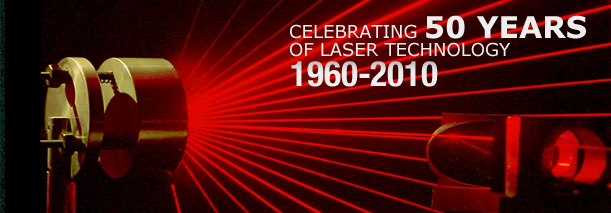HRL, Optical Physics & Optoelectronics
1960s
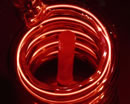
With
the advent of the laser,
Hughes researchers
continued investigations
with ruby and a variety
of other substances, including noble gases and water. The device
was a valuable tool for studying matter, and investigations of
its importance to communications began. Work in laser rangefinding
for the military led to the first long-distance laser link demonstrated
between Hughes’ Malibu and Culver City facilities. Researchers
also began investigating holography, which was made possible
with the invention of the laser.
1970s
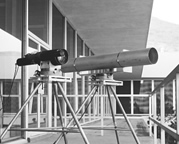
Laser
rangefinding became
a multi-billion dollar
industry for Hughes
into the 1970s. The company became an established leader in developing
complex integrated circuits with micrometer dimensions for use
in integrated microwave circuits and in new integrated optical
circuits that were developed in the exciting new field of fiber
optics. In 1978, scientists invented a technique for manufacturing
glass optical fibers with the strength of steel wire. These fibers
were used in Hughes' Fiber Optic Guided Missile Program, FOG-M,
and enabled missile flight to be controlled by light signals
and television pictures to be transmitted from a missile to the
ground launch site.
1980s
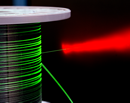 Optics
became a main focus
in the 1980s, leading
to the manufacture
of fiber optical
cables for controlling
and testing microwave
radar antenna systems.
Optical phase conjugation
techniques were developed
for atmospheric compensation—sending a light beam into the
atmosphere, bouncing
it off an object,
and having it return
to Earth with similar
sharpness, thus removing the blurring effects of atmospheric turbulence.
Optics
became a main focus
in the 1980s, leading
to the manufacture
of fiber optical
cables for controlling
and testing microwave
radar antenna systems.
Optical phase conjugation
techniques were developed
for atmospheric compensation—sending a light beam into the
atmosphere, bouncing
it off an object,
and having it return
to Earth with similar
sharpness, thus removing the blurring effects of atmospheric turbulence.
1990s
 Heading
into the 1990s, researchers
continued to set
records with microelectronics
and optoelectronic
circuits using Indium
Phosphide as the
substrate material
because it is the
only material in
which analog, digital
microwave circuits,
lasers and other
optical devices can
be fabricated on
the same chip. The
capability led to
systems on a single
chip, a concept that
continues to mature
with new materials
and nanotechnology.
Heading
into the 1990s, researchers
continued to set
records with microelectronics
and optoelectronic
circuits using Indium
Phosphide as the
substrate material
because it is the
only material in
which analog, digital
microwave circuits,
lasers and other
optical devices can
be fabricated on
the same chip. The
capability led to
systems on a single
chip, a concept that
continues to mature
with new materials
and nanotechnology.
2000s
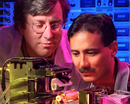 HRL continues to make major
contributions to the
application of photonics
in ultra-wideband signal
processing and in the
development of RF photonic
links for antenna remoting. We've
developed high-power
solid-state lasers and
demonstrated new concepts
for coherent beam combining. These
milestone accomplishments
have led to the demonstration
of photonic analog-to-digital
conversion, optoelectronic
integrated circuits with
on-chip photodetectors,
high-Q silica and Si
microresonators, Yb:YAG
lasers (demonstrated
in Maiman's ruby laser
laboratory), and other
solid-state laser oscillators
and amplifiers.
HRL continues to make major
contributions to the
application of photonics
in ultra-wideband signal
processing and in the
development of RF photonic
links for antenna remoting. We've
developed high-power
solid-state lasers and
demonstrated new concepts
for coherent beam combining. These
milestone accomplishments
have led to the demonstration
of photonic analog-to-digital
conversion, optoelectronic
integrated circuits with
on-chip photodetectors,
high-Q silica and Si
microresonators, Yb:YAG
lasers (demonstrated
in Maiman's ruby laser
laboratory), and other
solid-state laser oscillators
and amplifiers.
About US
First Laser
Maser to Laser
HRL and Laser Technology
Maiman's Bio
Maiman's Work (pdf)
Early Press Releases (pdf)
June 19, 1962 New Laser Pumped Maser May Close Gap in Spectrum
December 3, 1962 New Liquid Laser Developed by Hughes Scientists
May 15, 1964 Newest Hughes Lasers Cover Wide Spectrum
February 18, 1965 Hughes Develops CW Ruby Laser at Room Temperature
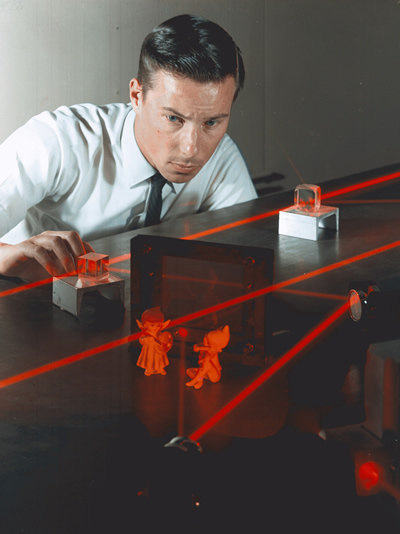
1967: Hologram Exposure Set Up
The laser enabled the development of holography—the ability to view 3D images in space. The set up above was for photographing stationary objects, but researchers also demonstrated motion picture holography.

